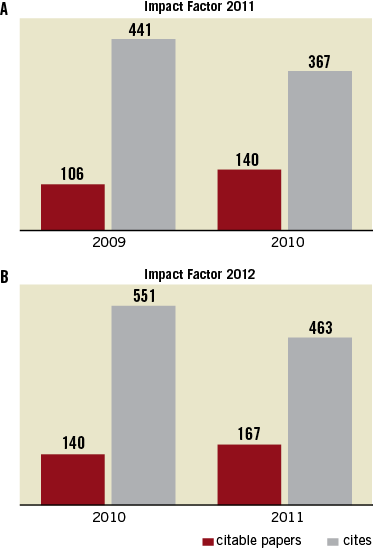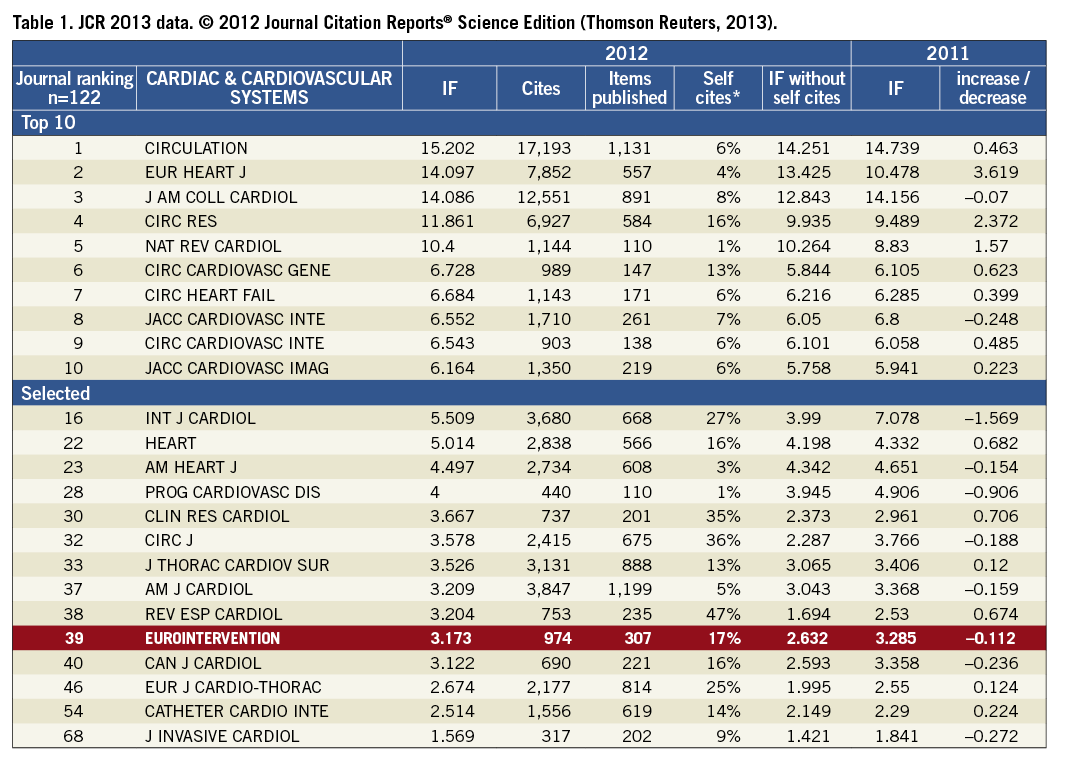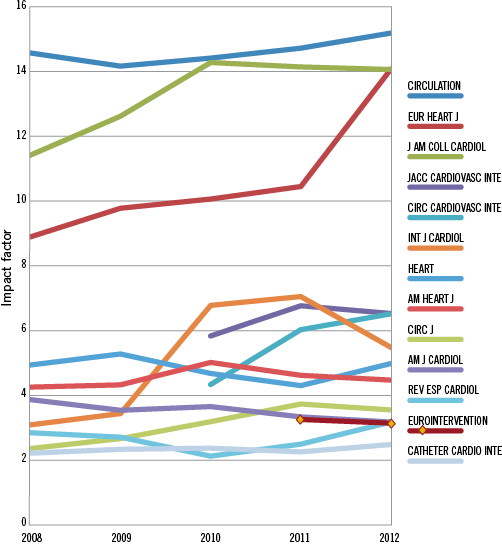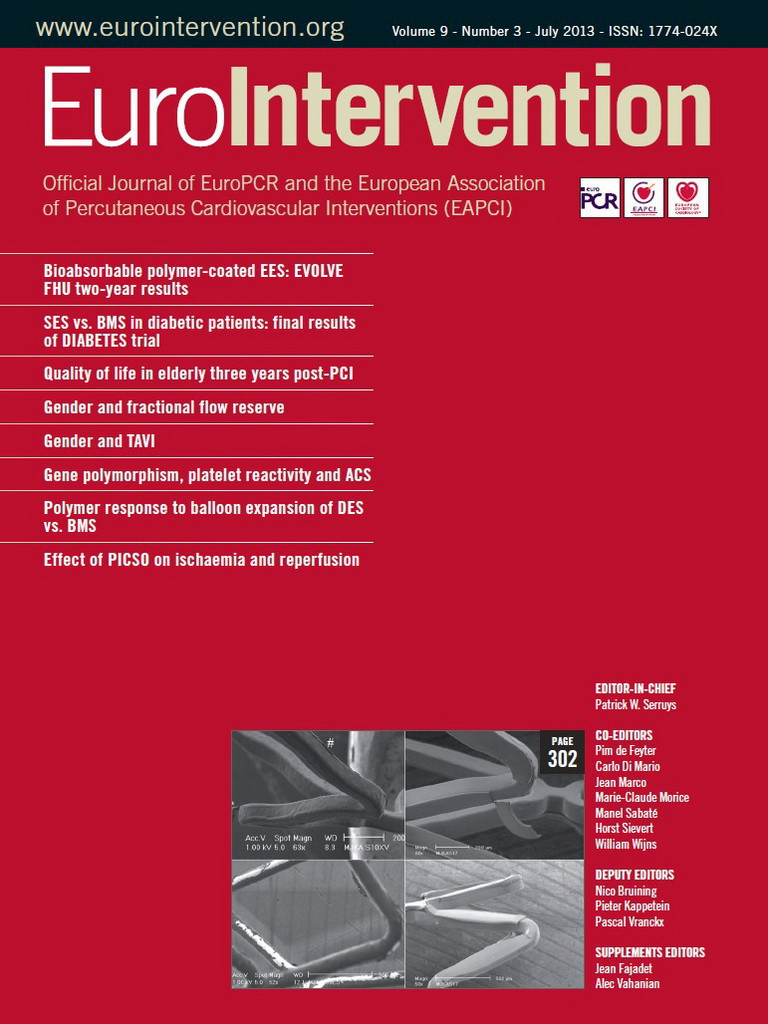At the very moment we were going to press with this current issue of EuroIntervention, we received the announcement of the 2013 release of Thomson Reuters’ Journal Citation Reports® (JCR)1. This year’s release announced the 2012 Impact Factor for EuroIntervention: 3.173, a result we can be proud of.
This yearly announcement is always eagerly anticipated by editors, publishers and authors alike and never fails to generate lively discussions, once the release is available. The JCR this year lists 10,853 journals across 232 disciplines, with 83 countries represented. This year, 379 journals received their first Impact Factor (IF). Within our category Cardiac & Cardiovascular Systems, five new journals have been added to the report, up from 117 to 122. The competition is fiercer than ever before, especially when you consider that a mere five years ago our category encompassed only 79 journals. For the Editorial Board it has become crucially important to differentiate EuroIntervention from the other publications, not only from an IF point of view, but also in author services. These include: the quality of our peer reviews, the speed of the first initial decision, the speed of the time from acceptance to publication, and in other reader services – innovative publications, educative formats, presentation of papers, not only in print format, but of course on the all momentous multimedia platforms.
Thomson Reuters reports that this year 55% of journals have seen their IF increase and 45% of journals have seen it decrease. Sixty-six journals have been “suppressed” from the JCR because of excessive self-citation. Thomson Reuters qualifies suppressed journals as extreme outliers in citation behaviour: 0.5% of the total 10,853 journals. The “penalty” for a suppressed journal is that it will remain suppressed for two consecutive years and only be re-evaluated in the third year using new data.
Naturally, one might imagine that we would be disappointed with this year’s IF as it is actually 0.112 lower than last year’s (which was our first impact factor). A few short observations should help to put our more than respectable impact factor into perspective.
Firstly, last year’s impact factor of 3.278 was calculated with the publication years of 2009 and 2010. In 2009 we published seven issues, with Thomson Reuters determining that, of those issues,106 papers were citable. For the year 2010, we published eight issues, with 140 citable papers. This year’s impact factor was calculated with the publication years of 2010 and 2011. The same data for 2010 was applied (eight issues, 140 citable papers), and 2011 data was applied as well (12 issues, 167 citable papers) Figure 1.

Figure 1. A) The papers published in 2009 had a citation maturation time of two years; papers published in 2010 had only one year to mature citations for the IF 2011 calculation. ©2011 Journal Citation Reports® Science Edition (Thomson Reuters, 2012); B) The papers published in 2010 had a citation maturation time of two years; papers published in 2011 had only one year to mature citations for the IF 2011 calculation. © 2012 Journal Citation Reports® Science Edition (Thomson Reuters, 2013)
Secondly, Table 1 illustrates that within the top 10 and other selected journals the yearly increase/decrease margins are very minimal, with only a very small number of outliers. Remarkably the levels of self-citations are, in most cases, quite modest. Figure 2 illustrates the impact factor trend of selected journals followed over the last five years.


Figure 2. An illustration of the impact factor trend of selected journals over the last five years. © 2012 Journal Citation Reports® Science Edition (Thomson Reuters, 2013).
We have written previously in our journal of the value of the IF, but we have also unveiled our criticisms of this method. We have discussed the position of the IF in the modern world including multimedia (website traffic and PDF downloads, arguably the true metrics of impact), where the modern use of social media platforms as vital and much used alternative sources of media dissemination has become more prominent in our daily work2. We reflected on our task and duty to continue with educative papers, which almost never gain a citation, such as the “How should I treat?” and “Tools & Techniques” formats. And yet, whilst recognising how old the IF is, and its inherent flaws, we still look forward to the announcement, like small children on Christmas Eve waiting for Santa Claus.
This “excitement” is not at all surprising when one considers a recent study involving 1,704 scientists from 86 countries covering all UNESCO major fields of knowledge. The authors reported that 31.4% of respondents deemed the IF “somewhat important” but, remarkably, 57% deemed the IF “very important” (n=1,704)3.
And finally, the Editorial Board of EuroIntervention would like particularly to congratulate Tom Lüscher and the entire European Heart Journal team for their IF of 14.097, which sees them moving up into second place within our category. We can see first-hand –via our collaboration in the EHJ– EIJ manuscript transfer system –how hard they work and this amazing jump well reflects their dedication and is justly rewarded. It would be a fantastic achievement for us as Europeans if EHJ can take first place next year!

